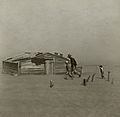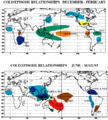Droughts in the United States facts for kids
Droughts in the United States are like dry spells that happen in other parts of the world. A drought occurs when an area gets much less precipitation (rain, snow, or sleet) than usual for a long time. This often happens when a high pressure system stays over a dry region for many days or weeks.
Droughts in the United States are often linked to natural climate patterns. These patterns include the North Atlantic oscillation, the Atlantic multidecadal oscillation, and the El Niño-Southern Oscillation. These big weather cycles help decide where and when droughts might happen across the country.
Droughts don't last forever. They are a natural part of Earth's climate and often switch with periods of floods over many years.
Contents
History of Major Droughts in the U.S.
The United States has experienced some very serious droughts throughout its history.
The Dust Bowl (1930s)
One of the worst droughts in U.S. history happened in the 1930s. This period is famously known as the Dust Bowl. It mainly affected the Great Plains region. Strong winds picked up dry soil, creating huge dust storms that covered everything. The 1936 North American heat wave was a big part of the Dust Bowl, making conditions even tougher.
Other Significant Droughts
Besides the 1930s, other major droughts hit the United States in the 1950s. More recently, there were also big droughts in the 1960s, 1980, 1983, 1988-90, 2002, and 2012-14.
The Costliest Drought (1988-1990)
The drought from 1988 to 1990 was the most expensive drought in U.S. history. It caused over $60 billion in damage. During this time, there were also severe heat waves. These heat waves led to many people getting sick or even dying. This drought was the costliest natural disaster in the U.S. before Hurricane Katrina.
Where Do Droughts Happen Most?
Droughts can affect any part of the United States. However, some regions are more likely to experience them. The Midwest, the Great Plains, and the Western United States are often hit hardest by dry conditions.
Images for kids
-
A farmer and his two sons during a dust storm in Cimarron County, Oklahoma, 1936. Photo: Arthur Rothstein.
-
Folsom Lake reservoir during the California drought in 2015. Droughts can cause water levels in lakes and reservoirs to drop very low.




